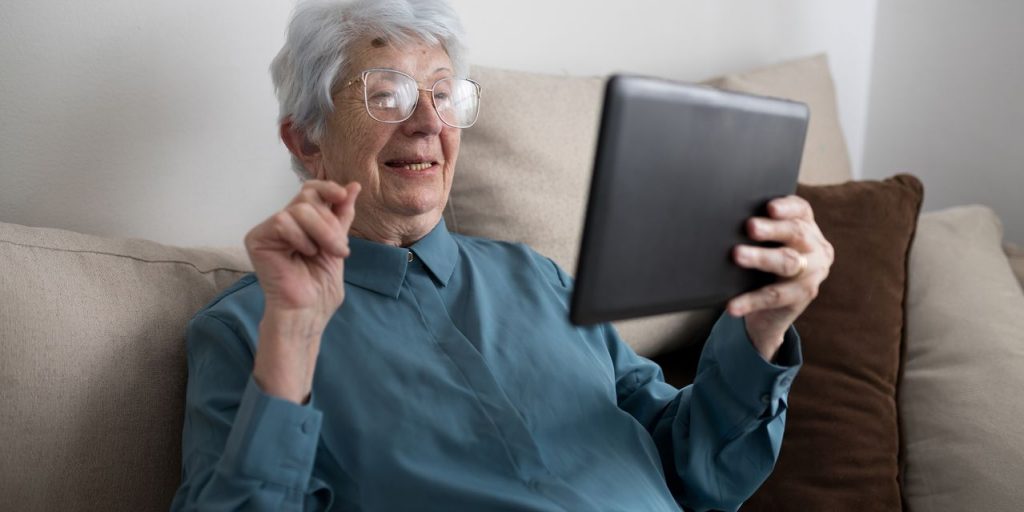This article is reprinted by permission from NextAvenue.org.
In 2014, the Windsor Park retirement community made headlines because of an innovative intergenerational program called “Speaking Exchange.” This program was started by a language school in Liberdade, Brazil, and the agency FCB Brazil to connect teens and older Americans via web chats at Windsor Parkin Chicago.
The goal was twofold: improve the English skills of young Brazilian students and reduce the loneliness of older Americans who are eager for conversation. However, such virtual programs have not become a staple in long-term care facilities.
Digital intergenerational activities are critical to promoting meaningful connections and increasing resident health. There is a compelling need for an innovative and creative approach to promoting social connection among older adults living in retirement communities.
As we saw, U.S. nursing homes were “ground zero” during the pandemic, as many residents endured 21 months with no visitors or group activities and health system disruptions. The toll of the lockdown on residents was significant, even among those who didn’t get COVID. Loneliness and social isolation were at an all-time high due to social distancing.
Read: Can virtual reality help older adults battle loneliness?
Backgammon and much more
Technology has a real impact on Americans’ daily lives because it can help build new relationships and friendships. But there’s so much more to engagement than just “feeling better,” said Brianna Bibel, a postdoctoral scholar at the University of California, San Francisco.
“My grandma loved backgammon, and she played with people from all over the world on her computer and chatted and made friends as she did so,” said Bibel. “Some of my first memories of the internet are using it to play backgammon with my grandma.”
Recently, new research reported on the success of programs that promote intergenerational interaction through digital means and how nursing homes can tap into this trend.
The study identified existing digital intergenerational programs used to reduce loneliness or social isolation among older adults and analyzed them regarding strategy, context, mechanisms and outcomes, or S-C-M-O.
Also see: My mother has to go into a nursing home. How do I get her the care she needs?
Searching for a holistic approach
Researchers revealed that different strategies should be adopted for other groups of older adults; for example, lonely older adults, older adults who reside in long-term residential care facilities and community-dwelling older adults.
According to the research, the S-C-M-O configurations influenced the success of intergenerational virtual programs and should be considered when designing and implementing such activities for older adults.
Ultimately, it is not enough to launch a virtual program.
“Loneliness is not an individual issue; it is a systemic issue that needs systems changes to transform,” said U.S. Surgeon General Vivek Murthy in a recent advisory. Murthy outlined six pillars to advance social connection.
For the fourth pillar, reforming digital environments, he explains that the framework encourages the development of “pro-connection technology to promote healthy social connection, create safe environments for discourse, and safeguard the well-being of users.”
While technology, when done right, can create healthy human relationships, we need to get rid of the stereotype that older adults are distrustful of technology. It is far from the truth because data from 2021 shows that 92% of people over 65 have cell phones. In addition, 67% of older adults access the internet, even if they use significantly fewer digital applications and spend less time online than younger adults.
Related: Apps for all? Why some older people are locked out by digital ageism
‘It improves my mood’
“Since receiving my iPad a few years ago, I have enjoyed catching up with my grandchildren, playing fun games and doing courses,” said 90-year-old Margaret Rose of Pomona, California, who lives with her family and frequently visits a nearby adult day center.
“I use it most times because it often gets me through the day, improves my mood and I wouldn’t change it for anything,” she adds, saying that she appreciates the fact that she can carry her iPad with her wherever she goes.
Every care facility, including older adult centers, assisted living and memory care, should strongly consider incorporating a digital intergenerational program into resident programming, even if it starts with collaborating with another organization.
Intergenerational virtual programs in long-term care are still a new concept. But the experience can optimize the well-being and quality of life of residents feeling socially isolated and lonely from the outside environment, including those who are bedridden or immobile.
The value of social connection
Paying for technology is an investment, but it is a significant economic value because the benefits can outweigh the costs.
Social connections are not only valid for older adults, but also for prison inmates, immigrants, people with disabilities, people in rural communities, and anyone else who might be isolated in our society, said Trish Lopez, a 2021 Next Avenue Influencer in Aging and CEO of Teeniors, a multi-award-winning company that includes teens and young adults who help older adults learn technology through one-on-one, personalized coaching.
“We have thousands of feedback reviews from our young coaches and older clients saying that our work has helped them feel less intimidated about engaging with others, connecting with their communities online and feeling like they are a part of the world instead of just being spectators,” said Lopez.
Sophie Okolo is a Forbes Contributor, Columbia University Age Boom Academy Fellow, and TEDMED Research Scholar. She is the founder and host of Global Health Aging, a creative consultancy and award-nominated resource featuring diverse opinions, news stories, and innovative research about longevity and healthy aging.
This article is reprinted by permission from NextAvenue.org, ©2023 Twin Cities Public Television, Inc. All rights reserved.
More from Next Avenue:



